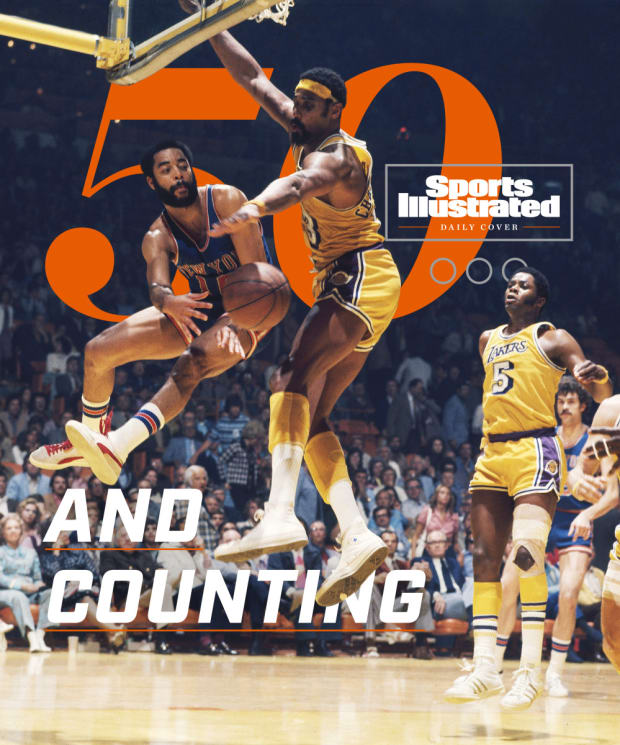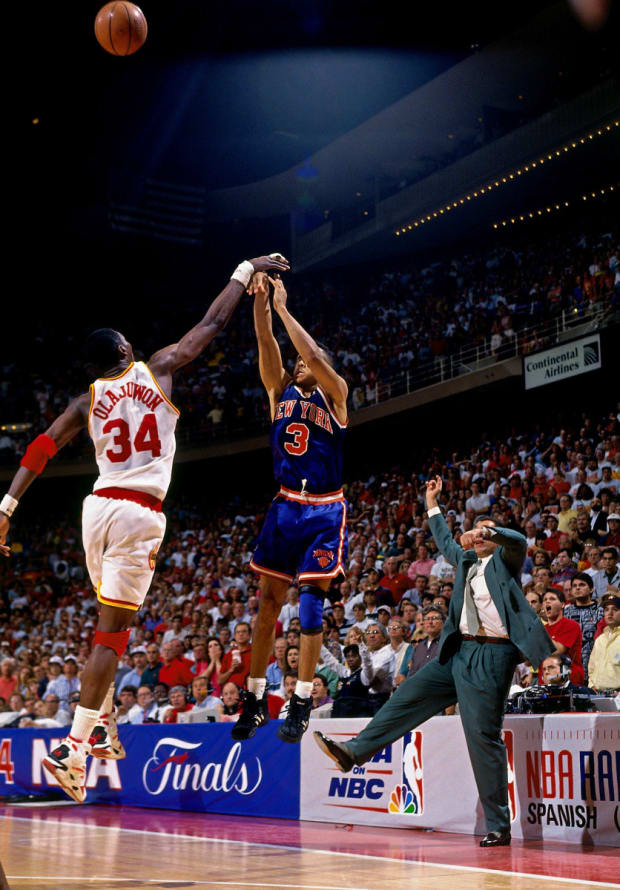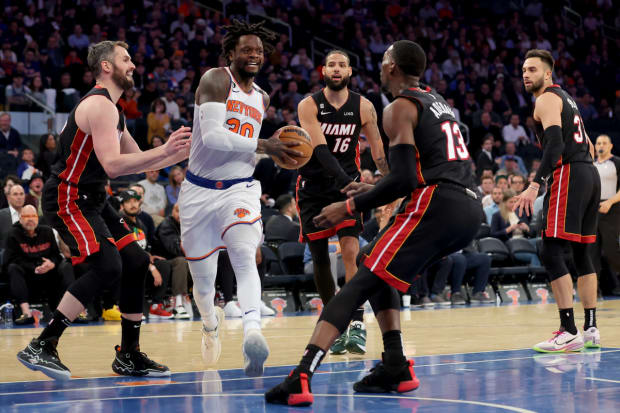On June 17, 1994, hours before the slow-speed chase involving O.J. Simpson would captivate the entire nation, more than one million New Yorkers clad in blue, red and white abandoned work, school and other responsibilities to descend upon lower Manhattan to celebrate the Rangers’ first Stanley Cup in 54 years.
The Knicks, under the same corporate umbrella as the hockey franchise, had a number of executives at the victory parade—not only to commemorate, but also to take logistical notes in case they managed to win the ultimate prize.
“So many people at the parade kept pointing at us saying, ‘You guys are next!’” recalls Dave Checketts, who served as Knicks president at the time. “I was too superstitious to handle any parade logistics before we’d won anything, but I did agree to have my most-trusted guy start dealing with the city on that stuff, just in case it did end up happening for us.”
The Knicks, who went up 3–2 in their NBA Finals series against the Rockets the night of the Simpson chase, had been in touch with Tiffany & Co. about creating an ice sculpture replica of the Larry O’Brien Championship Trophy for their potential parade. Stu Crystal, a Starter apparel brand executive, hauled a duffel bag filled with Knicks 1994 World Champions T-shirts and hats down to Houston.

Long Photography/Sports Illustrated
As guard John Starks’s last-second shot hung in the air during Game 6, Crystal stood ready in the tunnel leading to the court, prepared to put the apparel into the hands of New York players if the triple went down. (There was ample reason to believe it would: Starks scored 16 points in that fourth quarter, and had made his last six shots.) And waiting near the Knicks’ locker room was an entire pallet of champagne that team trainer Mike Saunders had gotten into the stadium.
They simply needed Starks’s shot to go in to turn it all loose.
But almost 29 years later, we know how the story ends: Starks’s attempt came up short; the result of Hakeem Olajuwon, the two-time Defensive Player of the Year, recovering to get a fingertip on it and altering the trajectory of the shot, and the story. And for as close as New York came to winning Game 6 because of Starks, the hot-and-cold swingman’s frigid Game 7—2-for-18 and 0-for-11 from deep after suffering insomnia in the nights before the deciding contest—was the primary reason the Knicks faltered in the series finale.
Now, as of this week—May 10, to be exact—it will have been 50 years since New York won its last NBA crown. Only four clubs (the Kings, Hawks, Suns and Clippers) currently own a longer title drought than the Knicks, who play in the nation’s biggest market and, for several years, spent more than any other franchise on their payroll. Nearly everyone tied to the franchise, from its former players, executives and coaches, will tell you the exact same thing.
“There’s no way I ever thought it would take this long to bring another title to New York,” says Checketts, who nearly oversaw an end to the drought.
“No way—I thought there’d be titles every five, six years,” said Clyde Frazier, the Knicks legend and longtime TV analyst, who was a member of those championship teams. “[1994] was the year they should have won it. I never thought this kind of drought would happen.”
If the past five decades have illustrated anything, it’s that those Knicks clubs from the early 1970s were flat-out special, even when weighed against other league champions. They had a brilliant coach in Red Holzman and were wildly skilled, on defense and as jump shooters. The members of the club also were incredibly smart, possessing a Rhodes scholar who would become a U.S. senator (Bill Bradley), a player who could memorize vast portions of phone books (Jerry Lucas), another with a Ph.D. (Dick Barnett) and a future Hall of Fame coach (Phil Jackson) who would go on to win 11 NBA titles.

Lou Capuzzola/NBAE/Getty Images
The team possessed legendary star power, fielding Hall of Famers in Earl Monroe (for the 1973 crown), MVP center Willis Reed, tenacious forward Dave DeBusschere, Bradley and Frazier. But above all else, the Knicks were known for their lack of selfishness and willingness to spread the ball around to the open man. In fact, Jackson acknowledged after his playing years that those pass-happy New York teams deflated basketballs shortly before their games, because they knew it’d make it tougher for opponents who relied on dribbling considerably more than they did. And, in light of the film-like sequence where a badly hobbled team captain Reed came out of the Garden tunnel to take the court just before Game 7 of the ’70 Finals, those Knicks were known for their toughness. That day, they knocked off the Lakers, who boasted the likes of Wilt Chamberlain, Jerry West and Elgin Baylor.
“We personified ‘team,’” Frazier said. “Everyone sacrificed, especially to get everyone involved.”
The teams since then have been known for all sorts of other things—good and bad.
In the early 1980s, as drug use became a bigger problem throughout the NBA, a number of New York players struggled to maintain their focus. The club even stopped scheduling practices at one point, because so many members of the team failed to show up for them.
“I had a friend in the city who would call me up and say, ‘Hey, man, so-and-so is up here buying drugs,’” recalls Butch Beard, who was an assistant with the Knicks when they went from having a 50-win club in the 1980–81 campaign to spiraling into last place with nearly the same roster the following year. “There were things I didn’t bother telling [Holzman], because he wasn’t ready to hear all that. He was used to the Clyde Fraziers and Willis Reeds, who were true pros. But those early-’80s teams were wild as hell, and the city gobbled them up.”
Record-setting injury absences and mismanagement also explained why New York—with Bernard King and Bill Cartwright—never saw consistency despite landing Patrick Ewing in the middle of the decade.
The 1990s were a bright spot because of Checketts’s decision to bring in Pat Riley, who immediately gave the team a rugged, no-nonsense identity the city fell in love with. Winning became routine in those years—five 50-win seasons between 1992 and ’97 and 14 straight playoff appearances from 1988 to 2001—with corporate Garden staffers treated to buffet lunches whenever New York won three straight games.
Michael Jordan was the clearest reason the Knicks, and just about everyone else, failed to make it to the winner’s circle that decade. But the club’s failure to put a consistent second star alongside Ewing, combined with costly playoff suspensions and Riley’s highly controversial exit for Miami, explained how the Knicks fell short of a crown in that window. Aside from the Finals loss against the Rockets in 1994, New York also lost to the Spurs in ’99, when the underdog Knicks made the title round, but didn’t have Ewing (Achilles) or a healthy Larry Johnson (knee).
Things changed rapidly at the beginning of the new millennium. Beloved coach Jeff Van Gundy, who had kept the team in title contention with his defense-first principles following Riley’s departure for Miami, resigned in December 2001. Checketts stepped down as Garden president about six months later. Just before those men left the organization, the Knicks traded Ewing, who had asked out of New York after feeling underappreciated. Van Gundy and Checketts tried to talk him out of the request, but eventually gave in, wanting to respect his wishes. The deal—which jettisoned Ewing with one year left on his contract—began a cycle of Knicks trades that bloated the struggling team’s cap sheets for years.
Around that same time, the club began showing a disinclination toward keeping around young talent despite drafting well. From when the team re-signed guard Charlie Ward in 1999, to this past summer when they brought back RJ Barrett, the Knicks had an unbelievable 23-year gap in which it opted against keeping one of its first-round draft picks on a multiyear extension. And none of that even speaks to the problems off the court, like the ugly sexual harassment lawsuit involving MSG and former Knicks coach and president Isiah Thomas, both of which ended up fighting and losing to the tune of $11.6 million in 2006.

Brad Penner/USA TODAY Sports
The following decade, New York aimed for the stars—vacating the roster and clearing out loads of salary-cap space in hopes of landing free agent LeBron James—only to end up failing to launch at all. In 2010, James chose to take his talents to Miami to team up with fellow studs Dwyane Wade and Chris Bosh, prompting the Knicks to instead sign Amar’e Stoudemire to a $100 million deal. During Stoudemire’s first season with New York, the club pulled off a megatrade for Carmelo Anthony.
“When I got there, it was not a good team,” says Donnie Walsh, the former Knicks president who ran the club from 2008 to ’11. “I was trying to do it through the free-agent market and trades. Carmelo, I think, proved out. Amar’e had the knee troubles that prevented him from playing and being as good as he had been, and it just didn’t work out. But I do think getting him led to Melo [wanting to come over via trade].”
Somewhat similar to the Ewing years, the Knicks never found an ideal running mate for Anthony, who led the Knicks to three consecutive playoff appearances, including the 2012–13 campaign, when New York landed the No. 2 seed and broke records for three-pointers. Stability was lacking during those years, too, as Anthony—a one-time scoring champion—played for five coaches over seven years and occasionally found himself at odds with Jackson, who had taken over as team president.
Only more recently have the Knicks shown real promise toward ending a drought that no one ever saw lasting this long. Team president Leon Rose hired a 1990s throwback coach in former Knicks assistant Tom Thibodeau, who won Coach of the Year in 2021. And Rose has been notably far more intentional about prioritizing homegrown player development, something that’s royally paid off this season. Immanuel Quickley finished second in Sixth Man of the Year voting, Mitchell Robinson had the highest offensive rebound percentage in the league and guard Quentin Grimes joined the starting lineup to give the club better two-way balance. Barrett had another uneven regular season, but he has shined in the playoffs and was one of the keys to the team’s convincing sweep of the fourth-seeded Cavaliers in the first round.
The Knicks, down 3-1 to Miami in the second round, are fighting for their playoff lives, one in which they’re relying heavily on Jalen Brunson, the club’s marquee free-agent signing last summer. Perhaps best of all for the organization: With an average age of 24.5, New York has one of the NBA’s youngest rosters, leaving flexibility and upside for the future.
This season’s group may not result in the Knicks ending the drought. But for the first time in a decade, it at least gives them a chance at taking part in a confetti monsoon in lower Manhattan. Between the promise of this young club, and how the past quarter century has gone, that’s a chance every Knicks fan will take.







